Where do you stand on becoming part person, part machine? This week we hook up with three pioneers in the field of cybernetics including walking cyborg Kevin Warwick, who volunteered his own nervous system to test out a new way to connect up with the machine world, Markus Groppe, who is trialling an implantable chip to restore vision to the blind, and Andrew Schwartz who's developing neural interfaces to couple the brain's motor circuits to a robot. Plus, news of an H5N1 'flu furore as scientists create the most dangerous virus imaginable, and a voyage to the deepest subsea vents ever discovered...
In this episode
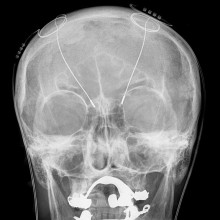
02:00 - What is cybernetics?
What is cybernetics?
with Kevin Warwick, Reading University
Kevin - Cybernetics is humans and technology linking together. So, it's the whole system. It's looking at how it all works together, so lots of practical examples. Cyborgs has perhaps been more of a science fiction thing in the past, where the technology and the human are integral. They're not separable, as it were, and the abilities, possibly could be much, much, more than humans alone.
Helen - Perhaps there are things that we do not consider as being cybernetics? Things like pacemakers and cochlear implants- we're quite familiar with that sort of technology - does that count?
Kevin - Well, to some people, it would. I mean, it's interesting to me. I'm 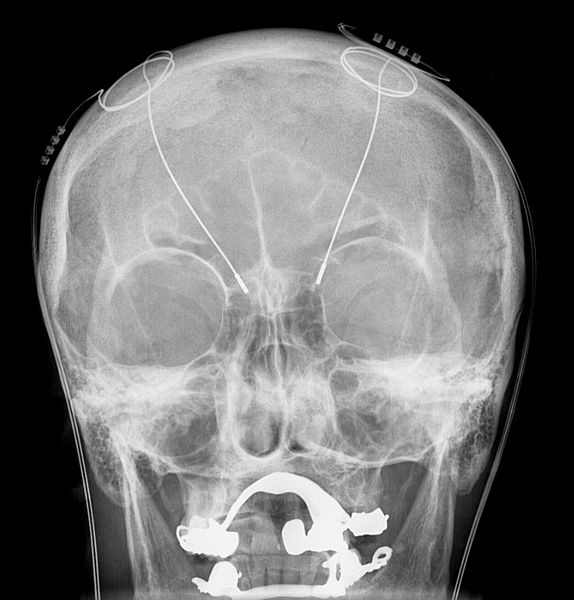 involved in working with Professor Tipu Aziz at the John Radcliffe Hospital, Oxford. They implant the deep brain stimulator. This is a long electrode, it's actually about 4 or 6 electrodes on the end of a long wire, pushed into the centre of someone's brain into the subthalamic nucleus, a small part of the brain, and an electrical pulse is applied there to overcome the effects of Parkinson disease. It's also being used now for depression and even in some cases, for Tourette's Syndrome, but what's interesting now is we can also take signals from the electrodes and monitor what's going on in the brain, hopefully to try and predict when people's tremors are going to start, things like that, but it's also giving a new insight in what the disease is. So you could regard it as a cyborg, in terms of cybernetics it's giving us more of an insight to actually what's going on in the person's brain.
involved in working with Professor Tipu Aziz at the John Radcliffe Hospital, Oxford. They implant the deep brain stimulator. This is a long electrode, it's actually about 4 or 6 electrodes on the end of a long wire, pushed into the centre of someone's brain into the subthalamic nucleus, a small part of the brain, and an electrical pulse is applied there to overcome the effects of Parkinson disease. It's also being used now for depression and even in some cases, for Tourette's Syndrome, but what's interesting now is we can also take signals from the electrodes and monitor what's going on in the brain, hopefully to try and predict when people's tremors are going to start, things like that, but it's also giving a new insight in what the disease is. So you could regard it as a cyborg, in terms of cybernetics it's giving us more of an insight to actually what's going on in the person's brain.
Helen - And what about the more far off things, the sort of things we might actually consider science fiction, really mixing machines with people? Where are we at with that kind of thing?
Kevin - All sorts of possibilities. I mean, one of the things we have done: growing neurons, culturing neurons, and then linking them up to a robot body. They're typically rat neurons because they were also studying with rat neurons but also, human neurons. So, we can actually look at how the neurons learn, how they connect together to make the robot move around and avoid objects and things like that. And in that sense, by applying new neurons, or stem cells over time, you can try and keep some of the memories, some of the way the robot operates in terms of this biological brain, keep it going, which gives hopefully a bit of an insight into things like Alzheimer's in terms of when neurons are dying off, can we add new neurons and so on, to keep the brain going? So it could help in the long term, but it's fun at the moment and it's experimental, it's very sort of frontline science.
Helen - One of the things that fascinates me the most is the idea of extrasensory perception, the idea of plugging myself in and being able to see or sense things that currently, I can't. Where are we at those sorts of areas of cybernetics?
Kevin - Well, the implant that I have had which
Andy Schwartz will talk about - maybe I shouldn't spoil it for people - he'll talk more about what the implant can do. But in my case, it was fired into my nervous system and I was able to experience ultrasonic signals. This is like sonar signals which gives you an indication of distance. So I had ultrasonic sensors on a baseball cap. Literally, the output of those were fed in by the implant into my nervous system. So I learned to recognise the pulses over a period of 6 weeks, but then was able to use it to detect where objects were. So it's only a small wire. It's like extending the senses if you like or having an ultrasonic sense but it shows that we can do that and therefore, in the future, having things like infrared, maybe stretching to things like x-ray. So it's not having a different visual, it's not seeing something but literally, it is sensing it in a different way. The human brain is very plastic, very adaptive in that respect.
Helen - And how did your brain adapt to having this implant taken out? That must have been quite strange to go back to normal.
Kevin - I mean, this is a science programme and I have to say, one of the key things was, we were absolutely exhausted. This was 3 months of research and at the end of it, I think we were in the lab every day, so I was a "lab rat" in that sense and I think exhaustion was the overriding thing. It was only something that we were doing in the lab, so sort of from time to time, it wasn't something that I was using in everyday life. I think if it had been, if I had this ultrasonic sense as a sort of permanent thing for a couple of months, I would've missed it, yes. But it was something we were really just experimenting within the lab, so it wasn't such a problem when it got taken out. It was the end of the experiment. We wanted to look at what had happened to the implant, and what had happened to the nervous system and things like that. So that was part of the experiment, part of the trial was that as well.
Helen - And looking ahead, where are the big challenges that lie ahead of you in terms of all of this research you're doing? Would you say that it's the scientific barriers that you have to break through or is it the ethics actually? I mean, that must presumably throw up a whole lot of issues, tangled up with the idea of part people, part machines, and where that's taking us.
Kevin - Yeah. I think it's a little bit of everything. Power is an issue. How do you power implants? Particularly if something's in the body, can we use body power? And there, I think possibilities with wireless transmission of power. That's tremendously exciting at the moment, so this is something Nikola Tesla spoke of. At the moment, if you're in your home, you've got power provided by wires. The possibilities of wireless power, that's certainly something we're researching. That could not just affect implants, but could affect vehicles. We can have powered vehicles, remotely powered vehicles, so it's tremendously exciting. But I think ethically, self-imposed ethics are one of those things. You don't want to injure somebody, you don't want to cause problems, but at the same time, ethics to do with human enhancement which is a possibility - extra memory, new ways of communication- is very difficult to decide what are the ethical aspects because there could be commercial opportunities, but it could also affect an awful lot of people.
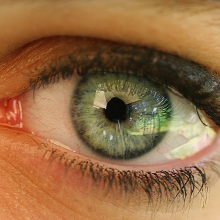
09:09 - Implants to improve impaired vision
Implants to improve impaired vision
with Dr. Marcus Groppe, Nuffield Laboratory of Ophthalmology
Chris - Taking a present example, the cochlear implant has been around since the 1970s and has helped over 200,000 profoundly deaf people to regain some sense of their hearing.
Well now, the stage is set for the visual equivalent of the cochlear implant and a team based at Oxford University are developing an implant that will return sight to people who have lost their natural vision, owing to disease processes like the disease retinitis pigmentosa.
We're joined by Dr. Marcus Groppe who's from the Nuffield Laboratory of Ophthalmology. Let's first of all look at what the disease is that you're trying to remedy. So, can you just fill us in on what retinitis pigmentosa is?
Marcus - Retinitis pigmentosa is a genetic disease, so a condition which is passed from generation to generation and it's kind of a mixed bag of conditions which are all grouped under the same name.
The main problem is that patients with this condition will lose their photoreceptors. So in our eye, at the back of the eye, we have a layer of cells which make up the retina, which works a bit like a sensor in a camera, or a film in a camera. One layer of the retina, the photoreceptors, convert light energy into an electric impulse.
Patients with retinitis pigmentosa have genetic defects which don't allow these photoreceptors to work properly over a long time and within their lifetime, they will get more and more degeneration of photoreceptors. Most of these patients are initially affected by losing peripheral vision and night vision, but later on, quite a lot of these patients loose central vision and eventually end up being blind.
Chris - And their diseases manifest just within those photoreceptor cells that convert the light waves into electrical signals, but presumably, you leave the other structures in the eye, including critically the optic nerve, intact?
Marcus - Yes, and most patients, if you wait long enough, there will be some more degeneration in layers of the retina which make up cells which form the optic nerve. But by the time patients actually become blind, the ganglion cells which form the optic nerve are still intact in most of these patients.
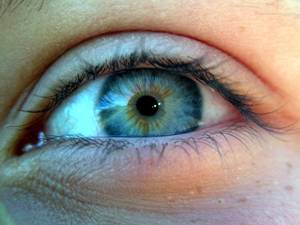 Chris - So if you can get signals back into them, then you can help them to experience at least some semblance of vision again. Is that your starting hypothesis?
Chris - So if you can get signals back into them, then you can help them to experience at least some semblance of vision again. Is that your starting hypothesis?
Marcus - That is exactly the idea behind the retina implant. So the retina implant we are using in our clinical trials which will start very shortly here in Oxford, is a chip which contains light sensors and an amplifier which converts the light energy into an electric impulse and then can connect to the ganglion cells so that the information of light is sent to the brain via the optic nerve.
Chris - So because you've lost the photoreceptors, the bits that see the light, your chip takes the place of those photoreceptors you've lost and then couples itself onto these ganglion cells that make the optic nerve that would transmit that signal into the brain?
Marcus - That is correct and the chip sits exactly at the same place where the photoreceptors used to be before the degeneration took place.
Chris - Wow! How big is it then?
Marcus - The actual active part of the chip is 3x3 mm and contains 1,500 light sensors, which gives you obviously a quite pixelated picture but theoretically can give enough information for patients to be able read big letters again. The main aim is to give patients who are completely blind some visual sensation back which helps them in everyday situations. For example, to find a door frame or to see a plate in front of them on a table, or to find things in their environment which they misplaced, which is very difficult for a blind patient who is only reliant on his feel and touch sensation.
Chris - How do you get the chip in, in the first place?
Marcus - It is an operation where a pocket of fluid is created via an injection underneath the retina to create some space for the chip to slide in and then a tunnel is created through the sclera which is the wide leathery bit of the eye, and the chip is then sliding towards the centre of our retina, the macula and the fovea, and is placed just underneath these structures because that allows the highest density of ganglion cells to project the best quality of picture to the brain.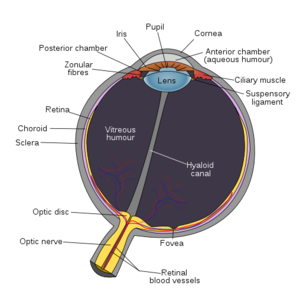
Chris - And how do you power the chip?
Marcus - With the same technology as it is for cochlear implants. So it is a magnetic plate sitting behind the ear and the chip is then powered by electromagnetic power, so everybody runs around with a small battery pack which then clicks onto the skin behind the ear via a magnet.
Chris - And what data have you got so far that this is going to be a success? The fact that you're going into humans argues that you must have satisfied enormous amounts of regulation and other preliminary data requirements to show that this is likely to work, but how soon do you expect to see results?
Marcus - At this stage, we are involved in a multicentre trial in Oxford here, so most of the work for this type of chip, and there are few other type of chips, was done in Tubingen in Germany, Currently, the state is that at this stage 1 trial, 11 patients have been implanted in Germany, and we will be starting to implant hopefully in a few months in Oxford in the first patient.
Chris - And how many people are you going to do in total? When will you know whether or not you've got a success on your hands? What's the long term follow up here?
Marcus - The trial is set to follow these patients up for one year and depending on the outcome, we are planning to do 18 patients in altogether 5 centres but that can be extended to about 32 patients.
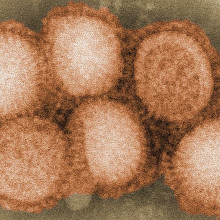
16:30 - Potentially Pandemic H5N1
Potentially Pandemic H5N1
with Mark Peplow, Nature; Ron Fouchier, Erasmus Medical Center, Rotterdam
Chris - A controversy that's even got governments involved! In September 2011, Dutch researcher Ron Fouchier gave a presentation at an Influenza Conference in which he showed how he'd been able to make, relatively easily, a form of bird flu - H5N1 that can transmit readily between mammals which is something that the naturally occurring form of the virus thankfully can't yet do. The results describe the structure of what Ron Fouchier himself describes as 'probably one of the most dangerous viruses that you can make' were sent to the journal Science for publication. But the paper has been suppressed on safety grounds, that the details could aid terrorists in creating weapons of mass destruction.
The journal Nature also has a similar bird flu paper waiting in the wings for the same reason. And now, both papers are currently under review by the US National Science Advisory Board for Biosecurity. So how should sensitive, but nonetheless very important, scientific results like this actually get handled? To find out more, I spoke with Mark Peplow, News Editor at Nature which this week asked authorities around the world this very same question.
Mark - Okay, so this all revolves around some research which has been done on the avian flu virus - H5N1. Two groups of researchers have basically made a mutant form of this virus which is more easily transmittable between mammals. Actually, they've tested it in the lab and it's ferrets that they use as it's more easily transmitted, just by ferrets breathing the same air and that raises concerns that these viruses, if they escaped, could also be transmitted between humans and potentially trigger a huge pandemic.
Chris - There are two aspects to this, aren't there? One, is should we be releasing the information as to how to make this very pathogenic viruses that transmit very efficiently because there's a question over, whether this is safe from a bioterrorism perspective. The other is, the public health perspective, in order for scientists to be able to work out how to mitigate this threat, they've got to know what the threat is.
Mark - Yeah, that's right and it's something that sometimes gets lost in some of the news reporting around this and that these mutant strains weren't born out of some reckless desire by mad scientists to push the boundaries of high risk science.
So the issue is, like you said, should this work be published? An awful lot of scientists say, "Yes, it absolutely should be published in full because it's important to understand how deadly these viruses are and potentially develop treatment against them." On the other side, there are some people out within the security community, but even scientists as well, that argue that the benefits that you gain from this sort of work are just not great enough to counter the risk of an accidental release or the possibility that a terrorist could get hold of the recipe, if you like and cook up some of these viruses themselves.
 Those in the security community take a broader issue which is some of the mechanisms for oversight of this sort of work really aren't sufficiently well-developed. They're saying, "Look, the argument about this is coming up when this work has already been done. It's about to be published" and the security community is saying, "Look, we need a much more stringent oversight system to make sure that these conversations start happening before the experiments go on and not after them."
Those in the security community take a broader issue which is some of the mechanisms for oversight of this sort of work really aren't sufficiently well-developed. They're saying, "Look, the argument about this is coming up when this work has already been done. It's about to be published" and the security community is saying, "Look, we need a much more stringent oversight system to make sure that these conversations start happening before the experiments go on and not after them."
Chris - And where does a journal like Nature stand on this? You've got some information that you want to publish which is for the good of the scientific community but may have political consequences. At what point does it become a problem with someone saying, you can't put that out?
Mark - Well because I'm the News Editor of Nature, I can't actually speak on behalf of the section of Nature which publishes scientific manuscripts, but I know what our Editor in Chief Phil Campbell's position is on this and that is that they acknowledge the concerns about this work and at the moment, there is no decision about whether to publish the papers or whether to publish a censored form of the papers. What we're waiting for is for the US government to provide details of, if the papers are censored, how it would allow genuine researchers to obtain that detail that would inform their own work. And as long as there is a safe but efficient system for getting that information, that scientific information, to legitimate researchers who need it, then both Nature and Science have said in statements that they would be happy to publish the papers in a reducted form so you basically outline what the researchers have done, but you don't give any of the recipes in public for how they did it.
Chris - Mark Peplow. But what is the work at the centre of this scientific storm? Ron Fouchier, the author of one of those papers.
Ron - We've been working on H5N1 viruses that are circulating currently in Indonesia and causing massive outbreaks and we've been studying transmissibility of this virus to humans and between humans.
Chris - Many people say H5N1 isn't a big worry because if it was going to jump into us, it would have done already. How do you respond to that?
Ron - Well, it is a big worry even when it jumps into us now because it kills people. It killed more than 400 people already and of course so far, there have been isolated cases but the fear is that the virus will adapt and will change genetically, such that it will become transmissible. And every case of infection of a human is a chance for the virus adapting to the human situation.
Chris - So when a virus does jump out of one host species like a bird in the case of H5N1, so it gets into humans, what does it actually take for it to grow efficiently in a human, a different host and then spread from one host to the next?
Ron - We know pretty much what it takes to infect the first human. We know very little of what it then takes to be transmissible between humans. They have to adapt to attach to other cells than they are used to attaching to, these cells express receptors and they have to adapt to new receptors, and they also have to adapt to produce enough virus such that the virus can spread and it does so by making genetic changes in the polymerase complex, and the polymerase complex is responsible for multiplication of the virus. But really, we don't know anything about what it takes to then become transmissible.
Chris - Many of the cases of H5N1 we've seen tend to stop with the person that gets infected, so they get it from a bird but then they don't pass it on. So how come they die of it, yet not pass it on?
Ron - So many of the human cases of infection, they contract the virus in odd ways - by drinking raw duck blood for instance or by getting the snot out of the beak of a fighting cock. And so, they get huge amounts of virus in and they get it generally deep down the respiratory tract. And deep down the respiratory tract, the virus can replicate quite efficiently. These individuals develop pneumonia and they die as a consequence of that. The virus is not particularly well adapted to replicate in the upper respiratory tract and we have always said that as soon as the virus gains the ability to replicate in upper respiratory tract of humans, then we might be in trouble.
Chris - So how are you trying to work out what it's going to take?
Ron - We borrowed evidence from previous pandemics when avian viruses changed and then caused infections in humans. And some of the changes that occurred in those pandemic viruses, we have introduced by genetic manipulation into H5N1 virus. And that H5N1 virus now replicates in the upper respiratory tract of mammals. Now that virus has many of the hallmarks of a pandemic virus, but we found initially that it's still is not transmitted. It's very surprising and so what we did then is put it into a mammal and let the virus adapt to the mammal for a few rounds and then take that virus, and then that virus will become transmissible. And so, by intelligent experiments, we were able to introduce three mutations into the virus and then because we didn't know the rest of it, we let the mammals do the rest of the story, and they accumulated two or three additional mutations or enough to make this virus transmissible.
Chris - Every time the virus goes into a new mammalian host, it has a new chance to adapt.
Ron - Yes, that's correct. So that's the message that we're sending out. Many of the mutations that we have introduced with genetic modification are already found in the field. So it's now a matter of chance of a mammal running into a chicken that has a virus with those mutations. And then in that mammal, it can accumulate the extra mutations and then we would be in trouble.
Chris - You're saying that the mutations that you put into your experimental virus already exist out in nature if you know where to look for them.
Ron - Yes. So far, there have been about 500 million birds infected and we have sequenced the genome of about 1,000 of them and in those 1,000 genomes, we already find the exact same mutations that we find in the transmissible virus, just not in the combination of 5 or 6 that we find in a transmissible virus.
Chris - Once you put those mutations or changes into H5N1, does it remain as pathogenic, as virulent, as the wild type or does it have to surrender some of that virulence in order to become fit to reproduce in humans instead of its more native bird?
Ron - Well we had all hoped and also thought that this virus would be reduced in virulence, but the first quick and dirty experiments that we have done suggests that the virus is just as hot as the wild type virus, and it kills a ferret in 3 days. In humans, kills 95% of the individuals that get infected.
Chris - What's the moral of the story?
Ron - To be honest, I think that many scientists have - well not just scientists but also the policy makers are relaxing a little bit too much on H5N1 at the moment. Many scientists believe that only H1, H2, and H3 viruses can cause pandemics rather than H5, and many scientists think that it has to involve pigs. Many scientists think that viruses need to shuffle their genes, rather than just build in mutations. And this investigation really showed that we should not be so relaxed about how to deal with the H5N1 virus, and I think the policy should be, to start stamping out H5N1.
Chris - And that was Ron Fouchier from the Erasmus Medical Centre in the Netherlands. He was speaking with me at the ESWI Influenza Conference held in Malta last September.
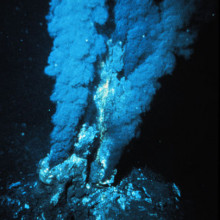
27:10 - The Deepest Deep Sea Vents
The Deepest Deep Sea Vents
Helen - Scientists have discovered the deepest and possibly the hottest undersea volcanic vents ever found and they're encrusted in extraordinary deep sea life. The Cayman trough gouge as a gigantic trench in the seafloor 5 km beneath the waves in the Caribbean Sea and it's there that a team of researchers led by Douglas Connelly and Jon Copley from the National Oceanography Centre in South Hampton detected a vast bloom of scorching mineral laden water reaching a kilometre up into the water column. Here's Geochemist Douglas Connelly.
Douglas - Cayman trough was identified quite awhile ago as one of the interesting missing pieces of the global ridge systems. It's isolated, sits on its own and it's also one of the deepest places, and one with the slowest spreading. It has been postulated that there wouldn't be any bending activity there at all, basically activities dependent upon spreading rate, as one of the old models that was out there. In the deep side, we've got extremely high pressure and perhaps the existence of supercritical fluids.
Helen - These supercritical fluids behave very strangely under the laws of physics. They're lighter than water but denser than vapour and the team think that these extremely deep vents which they call the Beebe vent field after the first scientist who explore the Deep Ocean could be one of the only places on the planet to study these fluids in a natural setting, including their effect on the way minerals are leeched out of rocks. Connelly and his colleagues found unusually high concentrations of copper in the fluids rising up from the vent which indicates the presence of these supercritical fluids. And along with the height of the vent plume, four times higher than that of other Deep Sea vents, suggests that water could be as hot as 450 degrees Celsius. And despite the enormous pressure, life down there is thriving as the team discovered by sending down a robotic submarine to take a look. Here's Marine Biologist Jon Copley.
Jon - Well as Biologists, we wanted to go and explore the Cayman trough Deep Sea vents for nearly a decade because we thought it might be a key missing piece in a global jigsaw puzzle. What was a surprise was actually yes, we've seen new species of shrimp down there, there may be new species of anemone at the deepest site, in their hundreds around the cracks that seep warm water from the seafloor. But these are very similar to animals that we know but from a long way away - 2,500 miles away in the Atlantic and it suggests there's a lot more traffic. Animals are getting around in the deep ocean perhaps a lot more than we thought before.
Helen - Another world first came from this study and that was the unexpected discovery of a hot vent in a much shallower site on the upper slopes of an undersea mountain called Mt. Dent. This sticks 3 km above the Cayman trough although its peak is still 2 km beneath the waves. The Mt. Dent vent was also found to be swarming in life and since submerged mountains like this are quite common, it hints that deep sea vents could be a lot more widespread than previously thought and they could offer stepping stones for vent animals to disperse between vent fields.

30:22 - Quitting Smoking, Exoplanets and Carnivorous Plants!
Quitting Smoking, Exoplanets and Carnivorous Plants!
with Gregory Connelly, Harvard School of Public Health; Martin Dominik, University of St Andrews; Geoffrey Gadd, University of Dundee; Caio Pereria, State University of Campinas.
Nicotine Replacement not the key for Smokers wanting to Break the Habit...
As many smokers try to fulfil resolutions to quit this month, nicotine replacement therapies have been shown to have no long-term benefits for smokers trying to kick the habit.
Following 787 adult smokers over five years, Gregory Connelly and colleagues from the Harvard School of Public Health found one third of smokers relapsed when trying to quit and saw no difference in this relapse between those using therapies such as nicotine gums and patches to those using other methods, or going cold turkey, in the long term.
Gregory - There's multiple factors for relapse. There's social cues, cigarette-driven cues, and it's probably diminishing over time of the personal will to quit. In the past, studies have looked at laboratory trials and then taken those findings and put them in the real world. What we found when you put it in the real world, and you look at the long term, they're just not having an effect. So what we have to do is combine our laboratory trials with trials from the real world. Combine them, learn, develop better mechanisms, and then make this planet smoke-free
---
Planets for Every star in our Galaxy...
Our galaxy hasas many planets as it does stars according to scientists at the University of St Andrews.
Using gravitational microlensing to find planets located further away from their stars, Martin Dominik and colleagues discovered a large population of planets which calculations estimate to equal the number of stars in the Milky Way and further showed that stars without associated planets could be the exception.
Martin - In the Milky Way alone, we're seeing 100 billion to 300 billion stars in there. Now we took a small sample and we find that another planet is actually comparable to the number of stars or even larger, so that means just in the Milky Way alone, there could be 100 billion planets. Interestingly, we find that the abundance of the smaller planets is much larger than the number of gas giant planets like Jupiter or Saturn and that is quite interesting if you think about places where you're going to look for life.
---
Using Fungi to Fight Lead Pollution...
Fungi could hold the key to fighting lead pollution according to research published in the journal Current Biology.
A known environmental pollutant, lead is a widely used structural and industrial material worldwide with previous efforts to contain or control levels in contaminated sites proving challenging.
Now Geoffrey Gadd from the University of Dundee has found that fungi can be used to transform lead into pyromorphite - it's most stable mineral form.
Geoffrey - We made quite a remarkable discovery and that certain fungi can attack the metallic lead which will result in a completely new mineral form - pyromorphite - which is a kind of lead phosphate and in fact, it's the most stable leadmineral that exists in the earth's crust So we've shown that really, activity of living organisms can do this which gives the intriguing possibility that perhaps somehow you could encourage the organisms to do this or act themselves in polluted sites.
---
Worming a Plant meal...
And finally, a carnivorous plant residing in the tropical savannahs of the Brazilian Cerrado region uses sticky underground leaves to trap and digest nematodes.
Ciao Pereira from the state university of Campinas fed nematodes labelled with isotopes of nitrogen to the plant Philcoxia Minensis and found significant levels of nitrogen thereafter in the leaves of the plant, proving the plants digestion and absoroption of the worms.
It's thought the plant uses phosphatase enzymes to directly breakdown the nematodes for nutrition.
Ciao - This plant is producing enzymes and digesting the nematodes that gets trapped within the sticky leaves and this suggests that there is more conspicuous ways and more strategies that the plants are using to secure nutrients especially in severely stressed habitats.
The work was published this week in the journal PNAS.
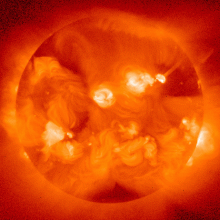
34:53 - Mapping Solar Storm Risk - Planet Earth Online
Mapping Solar Storm Risk - Planet Earth Online
with Dr Ciaran Beggan, British Geological Survey
Chris - The Earth is under constant bombardment by particles spewed out by the Sun. They're responsible for the spectacular aurorae - the so-called Northern and Southern Lights.
But solar storms can also disrupt satellites, communications and power supplies and so scientists have now produced the first ever map that shows which regions of the UK power grid are most at risk.
Dr Ciaran Beggan, from the British Geological Survey in Edinburgh, spoke to Planet Earth's Sue Nelson about both the map and the damage that can be done to power grids....
Ciaran - Aurora coincide with large scale changes in the magnetic field and magnetic field changes can induce electric currents in the ground. These are normally very small but when you get very large aurora then the electric fields can be larger. The electric fields or currents tend to flow through the rocks in the ground, but if they become large enough they can then flow through into the power system to the transformers which are connected into the ground.
Sue - Approximately how many of these power station transformers are there around the UK?
Ciaran - There are approximately 600 at the moment and they stretch all the way from the very north of Scotland, all the way down to the south coast of England.
Sue - There have been occasions around the world, famously one in Quebec, where these produce more than just a brief power outage don't they.
Ciaran - Yes, a very famous incident occurred in Quebec in 1989 where a very large geomagnetic storm, the largest one in that decade, caused a transformer to trip in Quebec. Then there was a chain reaction event all the way down the east coast of the US. A similar incident occurred in Sweden in 2003 and that was where, again, a geomagnetic storm triggered a collapse in a transformer which then caused all the electricity in the country to fail.
Sue - So how likely is that to happen in the UK? It is a real possibility?
 Ciaran - It's very hard to say how likely it is. At the moment we're just trying to identify where it might occur and that's what our map has tried to do. So, our map is basically a very simple representation of the UK power grid and what we do is we use the geology of the UK, because that's the controlling factor, to try and figure out how the electricity flows between one part of the UK and another when there is a very large geomagnetic storm. We've discovered that the extremities of the grid are the bits that are most likely to be affected by geomagnetic storms.
Ciaran - It's very hard to say how likely it is. At the moment we're just trying to identify where it might occur and that's what our map has tried to do. So, our map is basically a very simple representation of the UK power grid and what we do is we use the geology of the UK, because that's the controlling factor, to try and figure out how the electricity flows between one part of the UK and another when there is a very large geomagnetic storm. We've discovered that the extremities of the grid are the bits that are most likely to be affected by geomagnetic storms.
Sue - And by extremities you mean, maybe Cornwall for instance.
Ciaran - Yes, so the north part of Scotland is where the electricity tends to go into the grid and it will tend to flow out at the other extremities such as in Wales, in Norwich and in Cornwall.
Sue - Does that mean that the type of rocks in those particular areas, like Cornwall, like East Anglia are the same? What type of rock are we talking about?
Ciaran - Rocks have different electrical properties - so if you have a hard rock like a metamorphic rock or granite, for example, it tends not to conduct electricity very well. The electrical current will tend to flow into the surface, so it's much more likely to then flow into the power grid. Something like chalk or sandstone, which tends to be what the south of England is made from, is actually more porous, it tends to have a little bit more water in it and so the electricity will tend to flow deeper into the ground and that way it will avoid flowing into the national grid.
Sue - So you now know which parts of the UK are most at risk, because there's this map that you've produced and it's never done before. What can the power companies do about it?
Ciaran - One thing that they're going to do is install monitoring equipment at certain regions that are more likely to be effected. Over the years they do know that geomagnetic storms cause problems but they've never been able to understand quite where the problems are. This map will help them identify which regions they should have been installing equipment in and also which transformers they should be monitoring more closely for signs of damage, for example.
Sue - The Sun famously has its 11 year solar cycle, I assume this affects the possibility in the number of geomagnetic storms that you get during these 11 years as well, so what part of the cycle are we currently in?
Ciaran - So we've just come out of a very deep low part of the cycle and we're moving through the middle part of the cycle and it will peak in 2013, around about mid 2013 and it tends to fall off the end.
Sue - So this in fact is perfect timing then? You've produced the map with two years notice effectively for the power stations to act on your information and your advice?
Ciaran - Yeah, that's correct. This has been driven from Government level, there's been a lot of concern in the last couple of years that national hazards to the UK have may be not been studied as much as they could have been. So this is all part of looking at what natural hazards there are threatening the UK at the moment and solar geomagnetic storms are one of them we're looking at way of trying to understand and alleviate those effects.
Chris - Dr Ciaran Beggan from the British Geological Survey talking to Planet Earth podcast presenter Sue Nelson.
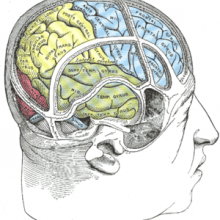
40:01 - Wiring the Brain to Robotic Limbs
Wiring the Brain to Robotic Limbs
with Professor Andrew Schwartz, University of Pittsburgh
Chris - Scientists are moving closer to developing ways to interface with the brain and to decode what nerve cells are saying to each other. Professor Andrew Schwartz is working on this at the University of Pittsburgh and he's with us now. Hello, Andrew.
Andrew - Hello.
Chris - What sort of signals are you trying to eavesdrop on?
Andrew - Well, we record from a part of the brain called the motor cortex and this part of the brain is thought to have a lot to do with controlling movements. We're particularly interested in arm and hand movements. So the neurons we record from seem to be related to aspects of moving the hand and arm, and particularly the direction and speed in which the hand moves.
Chris - In other words, if you were to look at the surface of the brain and specifically the bit of the brain that we know relates to movements, there's a map of a person, or the body, on the surface of the brain and different bits of that map relate to different body parts.
Andrew - That's right in sort of a coarse way. That's a general way of looking at it.
Chris - So when you are recording from different clusters of nerve cells, what does it sound like? What sorts of conversations do nerve cells have?
Andrew - So, we can record from individual nerve cells and the message that they send is the rate at which they fire action potentials. So action potentials are these little impulses of electricity and the time between those impulses carries the information. And so, what we've found is that, when you move your arm in different directions, that each neuron has a direction in which it likes to fire fastest in. We can take account of that to try to decode the way that you intend to move your hand. And so, over the years, we've built up a rather elaborate decoding mechanism where we can look at the direction and speed of the arm in 3-dimensional space and more recently, the angle of the wrist and now, the shape of the hand and fingers. So we can get pretty much a complete representation of what you're trying to do with your hand by tapping into these signals.
Chris - So rather than just turning individual muscles on and off, these motor cells in the motor part of the brain are active when they want to make a part of the body move to a certain position in 3-dimensional space. So, in other words, if you wanted to hold your hand out at 45 degrees to yourself, there would be a bunch of cells that would fire the most when you're going to do that.
Andrew - Right and the interesting thing is it's not just the cells that like to fire in that direction but the other cells will actually stop firing when you move against their preferred direction. So what we do is we look at the entire population because all the neurons carry some information about that movement. So one of the critical things about all this is that we look at the large population of cells, not just at a few individual neurons.
Chris - It's quite clever, so you're looking at things going off as well as things turning on. How many nerve cells do you record from? If you want to decode meaningfully what the brain wants to do, how many electrodes do you need?
Andrew - Well, we've used as few as 30 neurons to get a good representation of X, Y, and Z movement - 3-dimensional movement in space. But typically, what we do now is record from 100 to 200 neurons and we get a more elaborate decoding. So now, we can record or decode other aspects of movement as well.
Chris - So what's the next step? At the moment you can read those signals off, but translating that neurological chatter into something you want a computer to do or a robot to do, that's a whole different ball game, isn't it?
Andrew - Well, yes. Actually, the decoding principle we've known about more or less for 20 or 30 years just from doing basic research. We study monkeys and when monkeys move their own arms, we can record this activity and then correlate the activity to the monkey's own arm movement. Now on the last 10 or 15 years, what we've done is taken that signal and instead of using or correlating that to the monkey's own movements, we use that to drive a robot arm and the monkey can actually see that robot arm and control that robot arm without moving its own arm. So we've sort of taken and tapped this intention out and given it a behavioural meaning to the animal now.
Chris - And I suppose, one of the things which
Kevin [Warwick] was saying at the beginning is the brain is extremely plastic. So even if you are not recording from precisely the right cluster of cells to do exactly what you might want to do or want to achieve, with training, the individual, be it a person in the future or monkey today, could still nonetheless learn to think along the right lines. The brain would maybe rewire itself very slightly in order to achieve the desired movement using the electrodes you've plumed in.
Andrew - Actually, yes. That's one of the fascinating things. I would word it slightly differently. I'd say that we have to have a model of how this activity works, or what it's being used for, and our model is inaccurate. As you said, we're only recording from a few of the billions of neurons that fire during every movement. And so, our decode is rather inaccurate. But what the animal is able to do is to learn the algorithm that we're using to decode this and actually help us by making his neurons fire more in line with our model. So essentially, what the animal is doing is learning our model and helping us in that regard.
Chris - One can obviously see that if you can decode what the brain wants to do in people or individuals who have some kind of injury or an interruption of the flow of information from the brain to the motor centres in the spinal cord that would enable them to move, you could then reconstruct movements for them or enable them to control and interact with their environment better. What about going the other way though? What about putting information back into the brain? Would the same techniques you've developed to listen to neurons also enable you to talk to them?
Andrew - Well, that's an open area of research but that's exactly what we're trying to do. We're in process along with several other laboratories. What that would involve in our particular case is putting sensors on the robot's fingers and joints so that we can impart tactile information and joint information back to the subject. The way we hope to do that is by stimulating with electrical pulses again in the sensory regions of the brain to try to impart this information back to the subject.
Could you add a hard drive to your brain to increase memory?
Kevin - You can stimulate memories. That's about as far as we've got. By applying signals at particular parts of the brain, someone will go "Ahh! I can remember when I was a young kid" and so on. But actually, finding where they are, recording them [is a challenge]. Some people feel memories are quite spread around in the brain, so I don't know if we yet, fully understand what memories are. But I share the excitement, the possibilities. In the long term, one would hope we will be able to do, but I think it's a long, long way away yet. Chris - Andrew, what about the electrode side of this, because this is more where you're working. The brain machine interface quite literally. What about the concept of actually getting information in and out like that with an external hard drive? Andrew - Well again, as Kevin said, we know very little about how memory really works in the brain. There is a group that's trying to make, for instance, an artificial hippocampus, but I think at this point, it's a lot more engineering than it is science. So, again as Kevin said, there's hope for the future, but right now, I think we're quite a distance from that.
Could we target pain with cybernetics?
There's been a lot of good research on pain lately and there are a number of what we call "neuromodulatory devices" out there to try to stimulate different parts of the nervous system, both in the brain and the spinal cord, to try to alleviate some of these symptoms.
Is cybernetics just the next step in our evolution?
I think the next step is linking more directly with the brain. Even with using tools now, whether we're moving things or whether we're taking signals in through our ears and so on; it is the old way of doing it. There is an interface and if we can short circuit the interface to put signals directly into the brain or take signals from the brain, it's the next step. It's an evolutionary step how humans are now technologically speeding up evolution.
How do people feel when they have chips inside them?
Markus - So far, I'm seeing patients in the eye clinic who are interested in the technology because they are blind and it gives them the possibility to see things again. So they're highly excited to be part of research and be part of the project, but I would not think that they would consider themselves a cyborg or weird in any way. It's just a different form of camera technology which is connected directly to the eye rather than through the retina indirectly. Chris - Is this something you've come across Kevin? With people feeling a bit strange because they are literally now part man, part machine? Kevin - No, I think one thing that's interesting is that with an implant, even if it's an artificial hip, that sort of implant, very quickly, you regard it as being part of you. It's not like wearing a pair of glasses and you can put them down. When you get an implant, it's you. It's technologically different. I would guess that people with retinal implants, they wouldn't think of this as an implant. Very quickly, they'll think "Oh, it is me. I can do those things now." Which is tremendously exciting, how mentally you take these things onboard, just as much as physically.
Helen - Kevin, you've had a couple of implants yourself. Is the reason that you volunteered because you couldn't find anyone else to do it or because you wanted to do it yourself? Kevin - Actually, we get quite a few volunteers even now, and I actually have three of my undergraduate students who have implants. Not the same type, not the neural type, but to be honest, for me it was quite dangerous what we're doing, particularly the Utah array, the 100 electrodes firing into my nervous system, so there were dangers associated with that but I also wanted to experience for myself what it felt like.
Could we develop the ability to sense other fields like magnetic fields?
It is a very, very good point, very exciting. I have students at the moment, three students. We have ethical approval, they actually have magnets implanted in their fingers and they can feel - literally if they go into a bank they can feel EM [electromagnetic] signals. They have the magnet in their finger, a little coil of wire around the magnet and then that is attached to different sensory input. So, these are students doing the course, they can feel ultrasonic signals, feel distance, or feel infra-red which can be a heat signal. So it's converting different signals to magnetic signals. We haven't actually tested whether they can follow their finger and know which way to go as a compass would. That's an interesting one. We'll have to try that.
Could you provide a macrofocusing lens to help us read the small print?
I think to go with reading glasses is probably the much easier way than trying to do any complicated implants in that case!
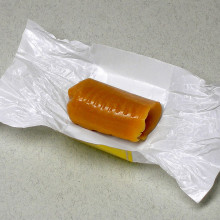
55:27 - Why does caramel cooking temperature rise in steps?
Why does caramel cooking temperature rise in steps?
We posed this question to Amy Chesterton from the University of Cambridge and retired science teacher John Wenham...
Amy - When you add heat energy to a simple substance, it leads to an increase in the kinetic energy of the molecules so the temperature increases. If we drew a graph of this, the temperature would increase along a straight line as we added more heat energy. Sugar syrup isn't simple though because there are chemical bonds between the atoms that form the molecules and even between the different molecules. These hold the water molecules and sugar molecules together, preventing them from evaporating when the mixture is cool. When the mixture is heated beyond a certain temperature, it begins to boil. This causes the molecules of water to break apart from one another, allowing the water to escape as steam. This uses up energy so the temperature increases more slowly while this is happening. At other temperatures, sugar molecules themselves begin to break apart which also consumes energy again, slowing the increase in temperature when this happens. At other temperatures, the sugar molecules begin to bond together to form long chains which is what is happening when you actually make caramel, forming new bonds like this releases energy which causes the temperature of the mixture to increase more quickly. This is why it's hard to only slightly caramelise sugar without burning it. So returning to the graph analogy from earlier, if you plot a graph of temperature against time for heating sugar syrup, there would flatter areas where bonds are breaking and steeper ones where they're being formed. Hannah - So, the inconsistent rise in temperature that Jeff observed whilst cooking his caramels was due to bonds, between water molecules and inside sugar molecules, being broken and new bond is being made as the caramel cooked. This caramel cooking conundrum caused quite a stir amongst all of you. According to retired science teacher John (Winnam) from Sussex... John - In the case of the caramel, the solid sugar will reach its melting point. Now when a solid melts, the forces of attraction that hold the particles of the solid together in a lump start to loosen and break and it's this process that absorbs the energy supplied instead of it being used to make the particles move faster. And consequently, the substance will stay at about the same temperature until melting is completed. Hence, the temperature of the mixture will not constantly rise.










Comments
Add a comment